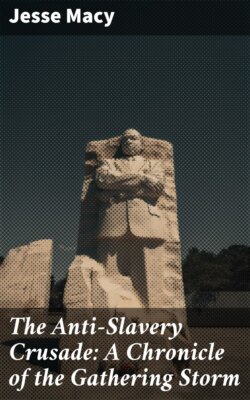The Anti-Slavery Crusade: A Chronicle of the Gathering Storm

Реклама. ООО «ЛитРес», ИНН: 7719571260.
Оглавление
Jesse Macy. The Anti-Slavery Crusade: A Chronicle of the Gathering Storm
The Anti-Slavery Crusade: A Chronicle of the Gathering Storm
Table of Contents
THE ANTI-SLAVERY CRUSADE
CHAPTER I. INTRODUCTION
CHAPTER II. THE GEOGRAPHY OF THE CRUSADE
CHAPTER III. EARLY CRUSADERS
CHAPTER IV. THE TURNING-POINT
CHAPTER V. THE VINDICATION OF LIBERTY
CHAPTER VI. THE SLAVERY ISSUE IN POLITICS
CHAPTER VII. THE PASSING OF THE WHIG PARTY
CHAPTER VIII. THE UNDERGROUND RAILROAD
CHAPTER IX. BOOKS AS ANTI-SLAVERY WEAPONS
CHAPTER X. "BLEEDING KANSAS"
CHAPTER XI. CHARLES SUMNER
CHAPTER XII. KANSAS AND BUCHANAN
CHAPTER XIII. THE SUPREME COURT IN POLITICS
CHAPTER XIV. JOHN BROWN
BIBLIOGRAPHICAL NOTE
Отрывок из книги
Jesse Macy
Published by Good Press, 2021
.....
The abolition of the African slave-trade was an act of the general Government. Congress passed the prohibitory statute in 1807, to go into effect January, 1808. At no time, however, was the prohibition entirely effective, and a limited illegal trade continued until slavery was eventually abolished. This inefficiency of restraint furnished another point of attack for the abolitionists. Through efforts to suppress the African slave-trade, the entire country became conscious of a common responsibility. Before the Revolutionary War, Great Britain had been censured for forcing cheap slaves from Africa upon her unwilling colonies. After the Revolution, New England was blamed for the activity of her citizens in this nefarious trade both before and after it was made illegal. All of this tended to increase the sense of responsibility in every section of the country. Congress had made the foreign slave-trade illegal; and citizens in all sections gradually became aware of the possibility that Congress might likewise restrict or forbid interstate commerce in slaves.
The West Indies and Mexico were also closely associated with the United States in the matter of slavery. When Jamestown was founded, negro slavery was already an old institution in the islands of the Caribbean Sea, and thence came the first slaves to Virginia. The abolition of slavery in the island of Hayti, or San Domingo, was accomplished during the French Revolution and the Napoleonic Wars. As incidental to the process of emancipation, the Caucasian inhabitants were massacred or banished, and a republican government was established, composed exclusively of negroes and mulattoes. From the date of the Missouri Compromise to that of the Mexican War, this island was united under a single republic, though it was afterwards divided into the two republics of Hayti and San Domingo.
.....